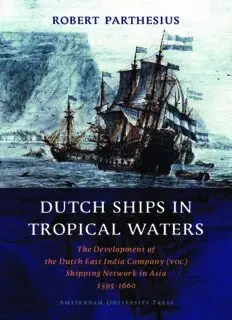
Dutch ships in tropical waters : the development of the Dutch East India Company (VOC) shipping network in Asia 1595-1660 PDF
Preview Dutch ships in tropical waters : the development of the Dutch East India Company (VOC) shipping network in Asia 1595-1660
* omslag Dutch Ships in Tropical:DEF 18-08-09 13:30 Pagina 1 robert parthesius d u t c h The end of the 16th century saw Dutch expansion in Asia, as s the Dutch East India Company (the VOC) was fast becoming an h Asian power, both political and economic. By 1669, the VOC was the i p richest private company the world had ever seen. This landmark study s looks at perhaps the most important tool in the Company’ trading i n – its ships. In order to reconstruct the complete shipping activities of the VOC, the author created a unique database of the ships’ movements, t r including frigates and other, hitherto ignored, smaller vessels. o Parthesius’s research into the routes and the types of ships in the p service of the VOC proves that it was precisely the wide range of i c types and sizes of vessels that gave the Company the ability to sail a – and continue its profitable trade – the year round. Furthermore, l it appears that the VOC commanded at least twice the number of w ships than earlier historians have ascertained. Combining the best of a maritime and social history, this book will change our understanding t e of the commercial dynamics of the most successful economic r organization of the period. s r Robert Parthesius is a naval historian and director of the o Centre for International Heritage Activities in Leiden. b e dutch ships in r t p a tropical waters r t amsterdam h studies e in the dutch s golden age i u The Development of s voc the Dutch East India Company ( ) 978 90 5356 517 9 Shipping Network in Asia Amsterdam University Press www.aup.nl 1595-1660 dissertation Amsterdam University Press DutchShipsinTropicalWaters Dutch Ships in Tropical Waters The development of the Dutch East India Company (VOC) shipping network in Asia - Robert Parthesius Founded in as part of the Faculty of Humanities of the University of Amsterdam (UvA), theAmsterdamCentrefortheStudyoftheGoldenAge(AmsterdamsCentrumvoordeStudievan de Gouden Eeuw) aims to promote the history and culture of the Dutch Republic during the ‘long’seventeenth century(c.-).TheCentre’spublicationsprovideaninsightintothe livelydiversityandcontinuingrelevanceoftheDutchGoldenAge.Theyofferoriginalstudies onawidevarietyoftopics,rangingfromRembrandttoVondel,fromBeeldenstorm(iconoclastic fury)toWareVrijheid(TrueFreedom),andfromBataviatoNewAmsterdam.Politics,religion, culture, economics, expansion and warfare all come together in the Centre’s interdisciplinary setting. Editorial control is in the hands of international scholars specialised in seventeenth-century history,artandliterature.Formoreinformationseewww.aup.nl/goudeneeuworhttp://cf.uba. uva.nl/goudeneeuw/. Coverillustration: C.P.Mooy,VOCshipsattheCapeofGoodHope,Amsterdams Historisch Mu- seum. Coverdesign:KokKorpershoek,Amsterdam Layout:Japes,Amsterdam ISBN e-ISBN NUR / ©R.Parthesius/AmsterdamUniversityPress, Allrightsreserved.Withoutlimitingtherightsundercopyrightreservedabove,nopartofthis bookmaybereproduced,storedinorintroducedintoaretrievalsystem,ortransmitted,inany form or byany means(electronic, mechanical, photocopying, recording or otherwise) without thewrittenpermissionofboththecopyrightownerandtheauthorofthebook. Table of contents Foreword Introduction DutchshipsinAsianwaters Purposeofthisstudy:‘Themissinglink’ Structureofthebook The database and methodology Introduction Shipsinthedatabase Shiptypesandrates:Classifyingtheships Terminologicalissues Thestructureofthevoyages Part Development of the VOC shipping network in Asia The Dutch expansion in Asia up to TheVoor-CompagnieënandtheVOC SearchingforasuitableorganisationinAsiaupto BuildingapermanentstructureinAsiaupto TheexpansionoftheVOCnetworkupto ThegeneraldevelopmentoftheAsianshipping Connecting the Asian regions: The tradingand shipping networkin operation after Introduction ThemainroutesinAsia Inter-regionaltransport:Thecompilationofthe‘returncargo’inthes The development of the VOCfleet Thehomeward-bounderorretourschip[Rate] Men-of-war[Rate] Ships[Rate] Yachts[Rate,,and] Frigatesandothersmallvessels[Rate] Prefabricatedvessels(Afbreekboots)[Rate] Flutes[Rateand] Miscellaneoussmallvessels[Rate] Availabilityofasuitablefleet:reviewofthecompositionofthefleetto The shipping and logistics in operation Introduction TheearlystageofDutchshippinginAsia LogisticsoftheshippingroutetoAsia LogisticsoftheshippingwithinAsia Loadingthefleet:ballastandcargoinAsia CrewingthefleetinAsia Knitting allthe threads together: The logistics of the network Bataviaasthespiderintheweboflogisticalorganisation SuccesoftheVOC:Attuningtheorganisationandthevariousnetworks Part The shipping and ships in numbers An analysis of the development of VOCshippingin Asia until Developmenttointen-yearintervals Fleets per region Interpretation Conclusions FocusontheDutchshippingnetworkinAsia TheDutchshippinginAsiato TheefficientDutchsystem AVOCfleetforAsia Inputofnewvesselsintothefleet Weavingitallintoanefficientmaritimenetwork Notes References Primarysources Printedprimarysources Secondarysources List of vessels in service by theVOC during the period - Index DutchShipsinTropicalWaters ThepeoplethatwecalltheRed-hairedorRedBarbariansareoneandthesameastheHollandersand theyliveontheWesternOcean. Theyaregreedyandcunning,haveampleknowledgeofvaluablegoods,andareskilledatseeking theirownadvantage.Forprofittheydonotevenhesitatetojeopardisetheirownlives,andnoplace istoodistantforthemtotryandreachit.[...] Whomeetsthematsea,willcertainlyberobbed. Thai-WanHoeTsi(afterGroeneveldt) Foreword ‘How tocreate amonsterandhow togetit backinitscage’seemstobeanappropriatemotto forthisresearchprojectofmine.Notbecausetheresearchandtheworkitselfturnedouttobe monstrous but because my own ambitions and the ensuing consequences went out of hand. What started with the idea of reconstructing the shipping history of some VOC ships in the thcenturygraduallyevolvedintoasystematicstudyonthewholeVOCfleetandtheirship- pingactivitiesin Asiauntil.Ihadinitiallyhopedformyresearchto justshed light onan underexposed aspect of the Dutch and Asian maritime history, but found wrestling with the evergrowingdatabaseofVOC ships inserviceand thevoyagestheymade. Meanttosupport me in the analyses of the development of the shipping network in Asia it turned out to be a projectandacreatureinitself.Todateitcontainsmorethan.recordsofvoyagestoabout individual destinations. Of these, . voyages between destinations in Asian areasarerelevanttothisstudy. Of course,this monsterwas created voluntarilyandprimarilynourished bymycuriosity to find out more about the maritime context the VOC ships were operating in. This interest was sparked already in the ’s during my research work for the Batavia-project, in first The Netherlands for the ‘replica’ building in Lelystad, and later also in Australia for the Western Australian Maritime Museum. Since then I have been privileged to be part of various other projects centred around the activities of VOC in Asian waters of which the Avondster project inSriLankawasthehighlight. IfeelprivilegednotonlybecauseIwasabletoworkonexitingprojectsbutaboveall,because itbroughtmeincontactwithwonderfulcolleaguesmanyofwhichhavebecomefriends.Here, I would really like to pay tribute to the team members of the various projects I worked on. Together with the support of other friends and colleagues from the Western Australian Mari- time Museum and the Amsterdam Historical Museum the writing of this publication became anacademicadventureratherthanthesynonymmoreoftenused:thelonesomequest. With so many people supporting my work it is difficult to single out some of them with a special acknowledgement. Still, there are a few that played a special role in the conception of thisresearch.Firstofall,thepeoplethatinspiredmetostartthisintellectualjourneybystimu- lating metolook always fora newquestion behind ananswer: JeremyGreen,BasKistand of course my supervisor Leo Noordegraaf. Then, the people who stimulated me to carry on and made it possible to fulfil this task: Isabelle Garachon, Camille Parthesius, Romain Parthesius. ThesupportIreceivedinthatrespectfromPaulineKruseman,directoroftheAmsterdamHis- torical Museum, was essential and heart warming. Special thanks to Menno Leenstra who be- came the driving force behind the establishment of the database by continuously collecting ‘trips and ships’and whose comments and advice were of invaluable importance to me. Het CentrumvoordestudievandeGoudenEeuw,oninstigationofitsdirectorHenkvanNierop,sup- portedmefinanciallytocompletethefinalstageofthisresearch. Then, there are those who just believed in this endeavour and therefore supported me im- mensely. There were many but four need to be singled out: Karen Millar, Albert van Nunen Karioen,MirandaVosandPatriciaMeehan.IalsowouldliketothankKarinaActon,Christine vanderPijl-KetelandFredLambertforreadingthetextandcorrecting‘myEnglish’. Although I enjoyed the whole process of this research tremendously, the real delight of the worklaidinthetailend.Duringthelastyear,whenthewritinganddecidingonthefinaldraft
